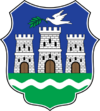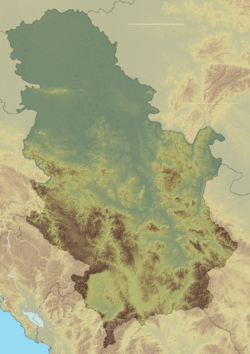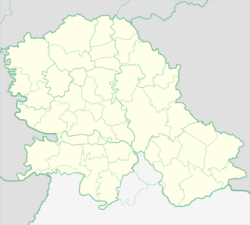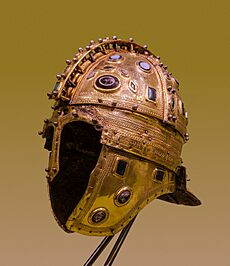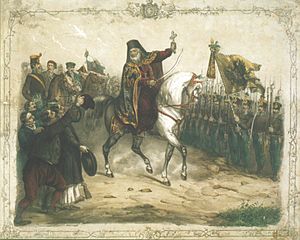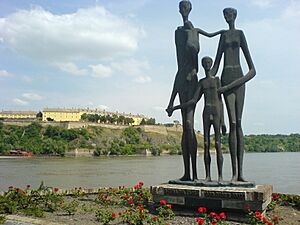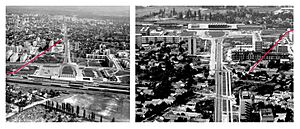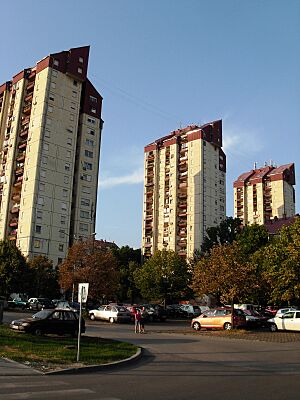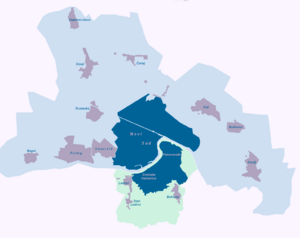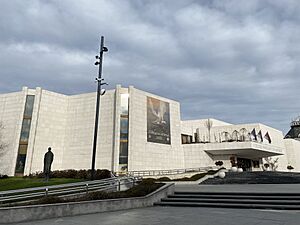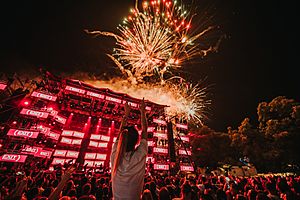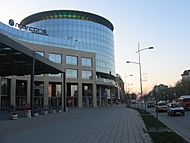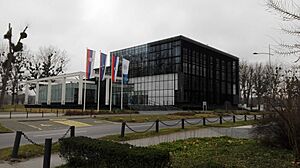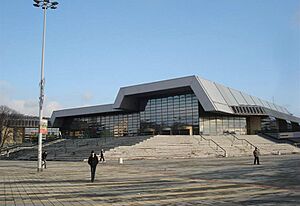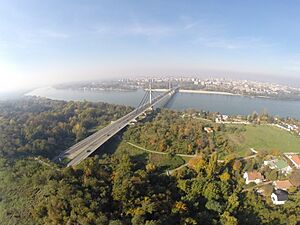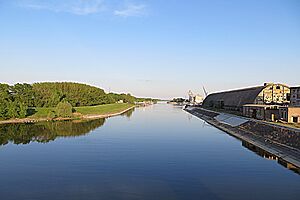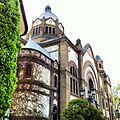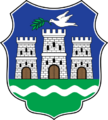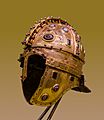Novi Sad facts for kids
Quick facts for kids
Novi Sad
Нови Сад (Serbian)
|
|||||
|---|---|---|---|---|---|
| Град Нови Сад Grad Novi Sad City of Novi Sad |
|||||
|
Panorama of Novi Sad
Novi Sad City Hall
Petrovaradin Fortress
Petrovaradin Clock Tower
Name of Mary Church
St. George's Cathedral
Matica srpska
Liberty Square
Bishop's Palace
Novi Sad Synagogue
|
|||||
|
|||||
| Nickname(s):
Serbian Athens
|
|||||
| Country | |||||
| Province | |||||
| District | South Bačka | ||||
| Settled by Scordisci | 4th century B.C. | ||||
| Founded | 1694 | ||||
| City status | 1 February 1748 | ||||
| Area | |||||
| • Administrative | 702.7 km2 (271.3 sq mi) | ||||
| • Urban | 129.4 km2 (50.0 sq mi) | ||||
| Area rank | 36th in Serbia | ||||
| • City proper | 106.2 km2 (41.0 sq mi) | ||||
| Elevation | 80 m (262 ft) | ||||
| Population
(2022)
|
|||||
| • Administrative | 368,967 | ||||
| • Rank | 2nd in Serbia | ||||
| • Urban | 306,702 | ||||
| • Urban density | 2,370.2/km2 (6,138.8/sq mi) | ||||
| • Metro | 414,195 | ||||
| Time zone | UTC+01:00 (CET) | ||||
| • Summer (DST) | UTC+02:00 (CEST) | ||||
| Postal code |
21000
|
||||
| Area code | +381(0)21 | ||||
| Vehicle registration | NS | ||||
Novi Sad (Serbian Cyrillic: Нови Сад) is the second largest city in Serbia. It is smaller only than the capital city, Belgrade. Novi Sad is also the capital of Vojvodina, which is an autonomous province.
The city is located in the southern part of the Pannonian Plain. It sits right on the Danube river, facing the northern slopes of Fruška Gora mountain. Novi Sad is the fifth largest city along the Danube river. It is also the largest Danube city that is not a country's capital.
In 2022, about 368,967 people lived in the Novi Sad area. This number includes the nearby towns of Petrovaradin and Sremska Kamenica.
Novi Sad was founded in 1694. Serb merchants started a community across the Danube from the Petrovaradin Fortress. This fortress was an important military base for the Habsburgs. Over the years, Novi Sad grew into a major center for trade, manufacturing, and culture. It was even called the Serbian Athens because of its cultural importance.
The city was badly damaged during the 1848 Revolution. But it was rebuilt and became strong again. Today, Novi Sad is a key industrial and financial center in Serbia, just like Belgrade.
Novi Sad was named the European Youth Capital in 2019. It was also the European Capital of Culture in 2022. In 2023, it became a UNESCO Creative City for Media Arts.
Contents
What's in a Name?
The name Novi Sad means "new plantation" in Serbo-Croatian. Its Latin name is Neoplanta. This name came from when the Habsburgs gave the city special rights.
Here are the official names of Novi Sad used in local government:
In Croatian and Romanian, which are official languages in the province, the city is also called Novi Sad. In the past, it was known as Neusatz or Neusatz an der Donau in German. This meant 'Novi Sad on the Danube'.
When people say "City of Novi Sad" (Grad Novi Sad), they often mean the whole administrative area. This includes Novi Sad itself, plus the towns of Sremska Kamenica and Petrovaradin, and many suburbs. Sometimes, "Novi Sad" refers only to the main urban areas. Other times, it means just the historic part on the left bank of the Danube.
A Look at History
Early Settlements in Novi Sad
![]() Principality of Hungary 895-1000
Principality of Hungary 895-1000
![]() Kingdom of Hungary 1000–1526
Kingdom of Hungary 1000–1526
![]() Ottoman Empire 1526–1687
Ottoman Empire 1526–1687
![]() Habsburg monarchy 1694–1804
Habsburg monarchy 1694–1804
![]() Austrian Empire 1804–1867
Austrian Empire 1804–1867
![]() Austro-Hungarian Empire 1867–1918
Austro-Hungarian Empire 1867–1918
![]() Kingdom of Serbia 1918
Kingdom of Serbia 1918
![]() Kingdom of Yugoslavia 1918–1941
Kingdom of Yugoslavia 1918–1941
![]() Kingdom of Hungary 1941–1944
Kingdom of Hungary 1941–1944
![]() SFR Yugoslavia 1944–1992
SFR Yugoslavia 1944–1992
![]() Serbia and Montenegro 1992–2006
Serbia and Montenegro 1992–2006
![]() Republic of Serbia 2006–
Republic of Serbia 2006–
People have lived in the Novi Sad area since the Stone Age. Old settlements and burial sites from 5000 BC have been found. One settlement was on the right bank of the Danube river, where Petrovaradin is today.
Later, Celtic tribes lived here, especially the Scordisci. They built the first fortress on the right bank of the Danube in the 4th century BC. Around the 1st century BC, the Romans took over. They built a larger fortress called Cusum, which was part of the Roman province of Pannonia.
In the 5th century, the Huns destroyed Cusum. By the end of that century, the Byzantines rebuilt it. They called it Petrikon or Petrikov. Slavic tribes, including Serbs, settled in the area around Novi Sad in the 6th and 7th centuries.
During the Middle Ages, different groups controlled the area. These included the Ostrogoths, Gepids, Avars, Franks, West Slavs, and Byzantines. Finally, the Hungarians took control. It was part of the medieval Kingdom of Hungary from 1000 until the Ottoman invasion in the 16th century.
Many settlements existed in the Novi Sad area during the Middle Ages. Some names, like Bivalo, show Slavic origins. Other names, like Vásárosvárad, are Hungarian. This shows that both Slavs and Hungarians lived in these areas.
Tax records from 1522 show a mix of Hungarian and Slavic names. After the Ottoman invasion in the 16th century, some settlements were destroyed. Most Hungarian residents left. The remaining settlements were populated by Serbs under Ottoman rule. In 1590, all 105 houses in the area were inhabited by Serbs.
How Novi Sad Began
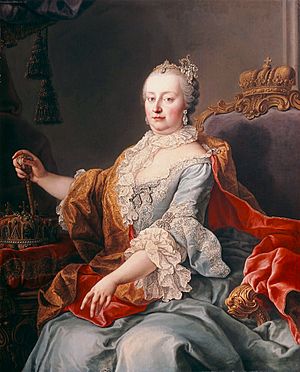
The Habsburg rulers were Roman Catholic. When they took control in the late 1600s, they did not allow Orthodox Christians to live in Petrovaradin. Because of this, Serbs started a new settlement in 1694 on the left bank of the Danube. They first called it the 'Serb city' (Srpski Grad). Another name was Petrovaradinski Šanac.
In 1718, people from the village of Almaš moved to Petrovaradinski Šanac. They created a new part of town called Almaški Kraj. By 1720, the settlement had 112 Serbian, 14 German, and 5 Hungarian homes.
The settlement officially became Novi Sad in 1748. It was declared a 'free royal city' by Maria Theresa. This meant it had special rights and freedoms. The edict was announced on February 1, 1748. It stated that Petrovaradinski Šanac would be renamed Neoplanta (Latin), Új-Vidégh (Hungarian), Neusatz (German), and Novi Sad (Serbian).
In the 18th century, the Habsburgs encouraged Germans to move to the Danube valley. They wanted to increase the population and improve farming. The government allowed German communities to practice their religion and speak their language.
Novi Sad Under Habsburg Rule
For much of the 18th and 19th centuries, Novi Sad was the largest city where Serbs lived. Vuk Stefanović Karadžić, a Serbian language reformer, said in 1817 that Novi Sad was the 'largest Serb community in the world'. It was a key cultural and political center for Serbs. They did not have their own country at that time. Because of its influence, the city was known as the 'Serbian Athens'.
In 1843, Novi Sad had 17,332 people. Most were Orthodox Christians, followed by Catholics and Protestants. Serbs were the largest ethnic group, and Germans were the second largest.
During the Revolution of 1848–49, Novi Sad was part of Serbian Vojvodina. In 1849, the Hungarian army at Petrovaradin Fortress attacked the city. This caused great damage and many people left. By 1850, only 7,182 citizens remained. Between 1849 and 1860, Novi Sad was part of a special Austrian region.
After 1867, Novi Sad became part of the Kingdom of Hungary. The Hungarian government tried to make people speak Hungarian. This changed the city's population mix. In 1880, 41.2% of people spoke Serbian and 25.9% spoke Hungarian. By 1910, more people spoke Hungarian (39.72%) than Serbian (34.52%).
Religious groups also changed. In 1870, there were more Orthodox Christians. By 1910, there were more Roman Catholics.
Modern Times: Serbia and Yugoslavia
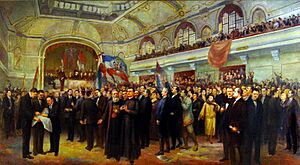
On November 25, 1918, an assembly in Novi Sad decided to join Vojvodina with the Kingdom of Serbia. From December 1, 1918, Novi Sad was part of the Kingdom of Serbs, Croats, and Slovenes. In 1929, it became the capital of the Danube Banovina province. In 1921, Novi Sad had 39,122 people. Most spoke Serbian, followed by Hungarian and German.
In 1941, during World War II, Yugoslavia was invaded. Novi Sad was taken over by Hungary. During the war, many citizens lost their lives. In January 1942, during the Novi Sad raid, Hungarian police killed many people. Citizens of all backgrounds fought against the Axis forces. In 1975, the city received the title People's Hero of Yugoslavia.
Yugoslav Partisans entered the city on October 23, 1944. Novi Sad then became part of the new Socialist Federal Republic of Yugoslavia. Since 1945, Novi Sad has been the capital of Vojvodina. The city grew quickly after World War II. Its population more than doubled by the early 1990s.
After 1992, Novi Sad was part of the Federal Republic of Yugoslavia. In 1999, during the Kosovo War, NATO bombing damaged Novi Sad. All three of its Danube bridges were destroyed. The city also lost communications, water, and electricity. Residential areas were bombed, and the oil refinery was hit daily. This caused a lot of pollution.
In 2003, the country became Serbia and Montenegro. In June 2006, these two states separated. Novi Sad then became part of the Republic of Serbia.
City Geography
The city is located on a bend of the Danube river. The river is only 350 meters wide near Petrovaradin. A part of the Danube-Tisa-Danube Canal forms the northern edge of the city center. Most of Novi Sad is on the left bank of the Danube, in the Bačka region. The towns of Petrovaradin and Sremska Kamenica are on the right bank, in the Srem region.
The left bank of the river is on a low part of the Pannonian Plain. Fruška Gora on the right bank is a mountain. The flat areas along the Danube are well-formed, especially on the left bank. A large part of Novi Sad is on a flat area about 80 to 83 meters high. The northern part of Fruška Gora has large landslide zones, but they are mostly not active.
The total land area of the city is 699 square kilometers. Its urban area covers 129.7 square kilometers.
Weather and Climate
Novi Sad has a humid subtropical climate. This means it has four clear seasons. Autumn is usually drier than spring, with long sunny and warm days. Winters are not too harsh, with about 22 days below freezing. January is the coldest month. The coldest temperature ever recorded was -30.7°C in 1963.
Spring is often short and rainy. Summer arrives quickly. The hottest temperature ever recorded was 41.6°C in 2007.
The Košava is a strong wind that blows from the Carpathians. It brings clear and dry weather. It usually blows in autumn and winter for 2 to 3 days at a time. The average speed of Košava is 25 to 43 km/h. But it can sometimes reach up to 130 km/h. In winter, with snowstorms, these winds can create large snowdrifts.
| Climate data for Rimski Šančevi, Novi Sad (1991–2020, extremes 1948–present) | |||||||||||||
|---|---|---|---|---|---|---|---|---|---|---|---|---|---|
| Month | Jan | Feb | Mar | Apr | May | Jun | Jul | Aug | Sep | Oct | Nov | Dec | Year |
| Record high °C (°F) | 18.9 (66.0) |
22.4 (72.3) |
30.0 (86.0) |
31.5 (88.7) |
34.2 (93.6) |
37.6 (99.7) |
41.6 (106.9) |
40.2 (104.4) |
37.4 (99.3) |
30.1 (86.2) |
26.9 (80.4) |
21.0 (69.8) |
41.6 (106.9) |
| Mean daily maximum °C (°F) | 4.3 (39.7) |
6.9 (44.4) |
12.7 (54.9) |
18.4 (65.1) |
23.1 (73.6) |
26.6 (79.9) |
28.8 (83.8) |
29.2 (84.6) |
23.9 (75.0) |
18.3 (64.9) |
11.5 (52.7) |
5.1 (41.2) |
17.4 (63.3) |
| Daily mean °C (°F) | 0.7 (33.3) |
2.3 (36.1) |
7.0 (44.6) |
12.4 (54.3) |
17.3 (63.1) |
20.9 (69.6) |
22.5 (72.5) |
22.4 (72.3) |
17.2 (63.0) |
12.0 (53.6) |
6.8 (44.2) |
1.8 (35.2) |
11.9 (53.4) |
| Mean daily minimum °C (°F) | −2.5 (27.5) |
−1.7 (28.9) |
1.9 (35.4) |
6.6 (43.9) |
11.4 (52.5) |
14.9 (58.8) |
16.1 (61.0) |
16.1 (61.0) |
11.8 (53.2) |
7.3 (45.1) |
3.2 (37.8) |
−1.2 (29.8) |
7.0 (44.6) |
| Record low °C (°F) | −30.7 (−23.3) |
−28.6 (−19.5) |
−19.9 (−3.8) |
−6.2 (20.8) |
−0.4 (31.3) |
0.2 (32.4) |
5.4 (41.7) |
6.9 (44.4) |
−1.6 (29.1) |
−6.4 (20.5) |
−13.8 (7.2) |
−24.0 (−11.2) |
−30.7 (−23.3) |
| Average precipitation mm (inches) | 38.9 (1.53) |
36.4 (1.43) |
38.6 (1.52) |
46.6 (1.83) |
77.3 (3.04) |
92.2 (3.63) |
68.1 (2.68) |
59.7 (2.35) |
58.8 (2.31) |
58.6 (2.31) |
51.5 (2.03) |
49.1 (1.93) |
675.8 (26.61) |
| Average precipitation days (≥ 0.1 mm) | 12.1 | 10.5 | 10.6 | 11.2 | 13.4 | 11.1 | 9.9 | 8.1 | 10.1 | 10.1 | 10.8 | 12.9 | 130.8 |
| Average snowy days | 6.4 | 5.8 | 2.7 | 0.4 | 0.0 | 0.0 | 0.0 | 0.0 | 0.0 | 0.1 | 1.9 | 4.9 | 22.2 |
| Average relative humidity (%) | 85.5 | 80.2 | 70.8 | 64.4 | 67.9 | 69.7 | 68.2 | 67.4 | 72.5 | 77.1 | 82.1 | 86.7 | 74.5 |
| Mean monthly sunshine hours | 67.9 | 100.6 | 164.1 | 205.8 | 257.3 | 284.8 | 316.2 | 298.9 | 207.1 | 160.9 | 94.7 | 59.4 | 2,217.7 |
| Source 1: Republic Hydrometeorological Service of Serbia | |||||||||||||
| Source 2: Meteo Climat (record highs and lows) | |||||||||||||
City Layout and Neighborhoods
Novi Sad's buildings look like those in other Central European towns. The City Hall and Court House were designed by Emmerich Kitzweger. The city was almost completely destroyed in the 1848/1849 revolution. So, most buildings in the city center are from the 19th century. Older, smaller houses used to surround the center. Now, modern, taller buildings are replacing them.
During the socialist period, new city areas were built. They had wide streets and multi-story buildings. But not many very tall, communist-style buildings were put up. Most buildings have three to six floors. In the 1960s, a new wide street, now called Bulevar oslobođenja, was built. It cut through older neighborhoods. This helped the city grow easily. Novi Sad's population has almost tripled since the 1950s. Even with many cars, traffic jams are not too bad.
City Neighborhoods
Some of the oldest neighborhoods are Stari Grad (Old Town), Rotkvarija, Podbara, and Salajka. Sremska Kamenica and Petrovaradin used to be separate towns. Today, they are part of Novi Sad's urban area. Liman and Bistrica were built in the 1960s-1980s. They have modern buildings and wide streets. Liman was divided into four sections (I–IV).
New neighborhoods like Liman, Detelinara, and Bistrica grew from fields and forests. After World War II, many tall apartment buildings were built. This was to house the large number of people moving from the countryside. Many old houses in the city center were torn down in the 1950s and 1960s. They were replaced by multi-story buildings. In the last 10 years, neighborhoods like Grbavica have changed a lot due to new construction.
Neighborhoods with single-family homes are usually further from the city center. Telep in the southwest and Klisa in the north are older areas like this. Adice and Veternik, west of downtown, have grown a lot in the last 15 years. This is partly because of people who moved from other parts of former Yugoslavia.
Suburban Areas
Novi Sad's main urban areas (Novi Sad proper, Petrovaradin, and Sremska Kamenica) have about 277,000 people. Its suburban areas have around 65,000 people. About 23.7% of the city's total population lives in these suburbs. There are 12 villages and 1 town in the suburbs. The largest numbers live in Futog (about 20,000 people) and Veternik (about 17,000 people) to the west. Both have grown and are now connected to the city.
Suburbs like Futog are officially towns. Other suburbs are mostly villages. Ledinci, Stari Ledinci, and Bukovac are villages on the slopes of Fruška Gora. Stari Ledinci is the most isolated village.
Towns and villages in nearby areas like Sremski Karlovci, Temerin, and Beočin use Novi Sad's public transport. They are also economically connected to Novi Sad.
| No. | Name | Status | City municipality | Population |
|---|---|---|---|---|
| 1 | Begeč | Village | Novi Sad | 3,325 |
| 2 | Budisava | 3,656 | ||
| 3 | Bukovac | Petrovaradin | 3,936 | |
| 4 | Čenej | Novi Sad | 2,125 | |
| 5 | Futog | Town | 18,641 | |
| 6 | Kać | 11,740 | ||
| 7 | Kisač | Village | 5,091 | |
| 8 | Kovilj | 5,414 | ||
| 9 | Ledinci | Petrovaradin | 1,912 | |
| 10 | Rumenka | Novi Sad | 6,495 | |
| 11 | Stari Ledinci | Petrovaradin | 934 | |
| 12 | Stepanovićevo | Novi Sad | 2,021 | |
| 13 | Veternik | Town | Novi Sad | 17,454 |
People and Demographics
| Historical population | ||
|---|---|---|
| Year | Pop. | ±% |
| 1798 | 6,890 | — |
| 1848 | 18,530 | +168.9% |
| 1900 | 28,763 | +55.2% |
| 1910 | 33,089 | +15.0% |
| 1921 | 39,122 | +18.2% |
| 1931 | 63,985 | +63.6% |
| 1941 | 61,731 | −3.5% |
| 1948 | 69,431 | +12.5% |
| 1953 | 76,752 | +10.5% |
| 1961 | 102,469 | +33.5% |
| 1971 | 141,375 | +38.0% |
| 1981 | 170,020 | +20.3% |
| 1991 | 198,326 | +16.6% |
| 2002 | 216,583 | +9.2% |
| 2011 | 277,522 | +28.1% |
| 2022 | 306,702 | +10.5% |
| Historical population | ||
|---|---|---|
| Year | Pop. | ±% p.a. |
| 1948 | 111,358 | — |
| 1953 | 120,686 | +1.62% |
| 1961 | 155,685 | +3.23% |
| 1971 | 206,821 | +2.88% |
| 1981 | 250,138 | +1.92% |
| 1991 | 265,464 | +0.60% |
| 2002 | 299,294 | +1.10% |
| 2011 | 341,625 | +1.48% |
| 2022 | 368,967 | +0.70% |
Novi Sad is the second largest city in Serbia. It is also the biggest city in Vojvodina. Since it was founded, the city's population has always grown. From 1961 to 1991, most people who moved to Novi Sad came from Vojvodina. Others came from Bosnia and Herzegovina and the rest of Serbia.
In the 1990s and 2000s, the city's population grew a lot. In 2011, the city had 231,798 people. Its urban area, including Petrovaradin and Sremska Kamenica, had 277,522 people. The whole administrative area of Novi Sad had 341,625 people.
Ethnic Groups in Novi Sad
Here is the ethnic makeup of the city's administrative area from the last three censuses:
| Ethnicity | 1991 | 2002 | 2011 | 2022 |
|---|---|---|---|---|
| Serbs | 173,420 | 225,995 | 269,117 | 289,119 |
| Hungarians | 20,245 | 15,687 | 13,272 | 9,792 |
| Slovaks | 8,165 | 7,230 | 6,596 | 5,458 |
| Croats | 8,848 | 6,263 | 5,335 | 3,877 |
| Yugoslavs | 32,803 | 9,514 | 2,355 | 3,465 |
| Romani | 1,133 | 1,740 | 3,636 | 3,321 |
| Russians | - | - | 329 | 2,766 |
| Montenegrins | 6,226 | 5,040 | 3,444 | 2,225 |
| Rusyns | - | 2,032 | 2,160 | 1,836 |
| Muslims | 1,737 | 1,015 | 1,138 | 886 |
| Gorani | - | 358 | 709 | 821 |
| Macedonians | - | 1,144 | 1,111 | 819 |
| Romanians | 902 | 860 | 891 | 706 |
| Albanians | - | - | 356 | 476 |
| Ukrainians | - | - | 484 | 454 |
| Slovenians | - | - | 412 | 365 |
| Germans | - | - | 429 | 294 |
| Others | 18,211 | 22,416 | 31,861 | 44,287 |
| Total | 265,464 | 299,294 | 341,625 | 368,967 |
All inhabited places in the city area have a Serb majority. The village of Kisač has a Slovak majority.
Religious Life
In 2011, the Novi Sad area had many different religious groups. Most people were Orthodox Christians (270,831). There were also 21,530 Catholics, 8,499 Protestants, 4,760 Muslims, and 84 Jews. The city is an important center for the Serbian Orthodox Church. It is also home to the Bishop of the Slovak Evangelical Church of the Augsburg Confession in Serbia. The Muftiship of Novi Sad for the Islamic Community in Serbia is also here.
Culture and Arts
In the 19th and early 20th centuries, Novi Sad was the main center of Serbian culture. This is why it was called Serbian Athens. Many Serbian writers, poets, lawyers, and publishers lived or worked here. These included Vuk Stefanović Karadžić, Mika Antić, and Jovan Jovanović Zmaj.
Matica srpska, Serbia's oldest cultural and scientific group, moved to Novi Sad in 1864. Its library is the second largest in the country, with over 3.5 million books. The Serbian National Theatre, one of the oldest professional theaters in the region, was founded in Novi Sad in 1861.
Today, Novi Sad is Serbia's second largest cultural center, after Belgrade. The city hosts many cultural events and music concerts. Since 2000, Novi Sad has been home to the EXIT festival. This is one of Europe's biggest summer music festivals. Other important events include the Sterijino pozorje theater festival and Zmaj Children Games. There is also the International Novi Sad Literature Festival and the Novi Sad Jazz Festival. Novi Sad also has a fashion show twice a year. It features local and international designers. This event, called Serbia Fashion Week, also shows works by artists, musicians, and architects.
Besides the Serbian National Theatre, other theaters include the Novi Sad Theatre and Novi Sad Youth Theatre. The Novi Sad Synagogue also hosts many cultural events. Other cultural places are the Library of Matica Srpska and the Novi Sad City Library. The city also has the Archive of Vojvodina. It keeps many old documents from the Vojvodina region dating back to 1565.
Novi Sad has several folk song groups, called kulturno-umetničko društvo or KUD. Famous ones include KUD Svetozar Marković and SZPD Neven, founded in 1892. Different national groups also have their own societies. For example, the Hungarian MKUD Petőfi Sándor and the Slovak SKUD Pavel Jozef Šafárik.
Novi Sad was chosen as the European Capital of Culture for 2021. But this was moved to 2022 because of the COVID-19 pandemic. From this, an industrial area in Liman became an artist quarter called Distrikt. Because of local artists, the city became a UNESCO Creative City of Media Arts in 2023.
Local Cuisine
You can find typical Serbian food in Novi Sad. This includes dishes like ćevapi, burek, and pasulj. There are also fish dishes, local cheeses, and cured meats. Restaurants and farms offer fresh food from local farmers. They also have wines from Fruska Gora's vineyards. Some top restaurants offer modern versions of traditional food.
Pastry shops serve local sweets. These include layered cakes made with nuts and cream, called 'torta'. Desserts often use raspberries, a major export from the region. Historic Dunavska Street has many ice cream shops.
The Index sandwich is a popular local street food since the 1980s. It is a bread roll filled with melted cheese, ham, mushrooms, and lots of sauce. It is named after university student index books.
City Museums and Galleries
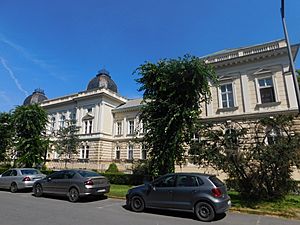
Novi Sad has several museums and art galleries. The most famous is the Museum of Vojvodina, founded in 1847. It shows the history of Serbian culture and life in Vojvodina from ancient times. The Museum of Novi Sad is in the Petrovaradin Fortress. It has a collection about the history of the old fortress.
The Gallery of Matica Srpska is the largest and most respected art space. It has two galleries in the city center. Other museums include the Museum of Contemporary Art of Vojvodina. There is also The Pavle Beljanski Memorial Collection. This collection has many Serbian art pieces from the 1900s to the 1970s.
Tourism in Novi Sad
Since 2000, more and more tourists visit Novi Sad each year. During the annual EXIT music festival in July, the city is full of young people from all over Europe. In 2017, over 200,000 visitors from 60 countries came to the festival.
Other events include shows and meetings organized by Novi Sad Fair. This brings many business people to the city. Every May, Novi Sad hosts the largest agricultural show in the region. In 2005, 600,000 people attended it. The tourist port, near Varadin Bridge, welcomes cruise boats from across Europe.
The most famous building in Novi Sad is the Petrovaradin Fortress. It stands out in the skyline and offers great views of the city. The nearby historic neighborhood of Stari Grad has many monuments, museums, and shops. The Fruška Gora National Park is also close by, about 20 km from the city center.
In 2023, Novi Sad had 234,708 tourist arrivals. This was a 7.2% increase from 2022. Tourists stayed for a total of 567,926 nights, which was a 1.2% growth.
City Economy
Novi Sad is the economic center of Vojvodina. This is the most fertile farming region in Serbia. The city is also one of the largest economic and cultural hubs in Serbia.
Novi Sad was always a developed city in former Yugoslavia. In 1981, its wealth per person was 172% of the country's average. In the 1990s, the city was badly affected by a trade embargo and very high inflation. This caused many important industries to decline or close. These included Novkabel (electric cables) and Pobeda (metal industry). Today, only the oil refinery and the thermal power plant are still large and active.
Novi Sad's economy has mostly recovered since 2001. It has changed from being mostly industrial to focusing on services. Most companies are now privately owned. Small and medium-sized businesses are very important for the city's growth.
Novi Sad is also a key financial center. It is home to the main offices of many banks, like Erste Bank. It also has the third largest insurance company in Serbia, DDOR Novi Sad. Major energy companies like Naftna Industrija Srbije (oil) and Srbijagas (gas) are also based here. Many farms for wheat production and trade are also located in the area.
Novi Sad is also a growing information technology (IT) center in Serbia. It is second only to Belgrade. About 900 IT companies operate in Novi Sad. As of September 2017, Novi Sad has one of 14 free economic zones in Serbia.
Here is a look at the number of people working in different types of jobs in Novi Sad (as of 2022):
| Activity | Total |
|---|---|
| Agriculture, forestry and fishing | 1,633 |
| Mining and quarrying | 749 |
| Manufacturing | 25,675 |
| Electricity, gas, steam and air conditioning supply | 1,474 |
| Water supply; sewerage, waste management and remediation activities | 1,769 |
| Construction | 10,624 |
| Wholesale and retail trade, repair of motor vehicles and motorcycles | 28,527 |
| Transportation and storage | 8,904 |
| Accommodation and food services | 7,229 |
| Information and communication | 13,086 |
| Financial and insurance activities | 4,717 |
| Real estate activities | 845 |
| Professional, scientific and technical activities | 13,115 |
| Administrative and support service activities | 6,902 |
| Public administration and defense; compulsory social security | 8,080 |
| Education | 14,068 |
| Human health and social work activities | 12,752 |
| Arts, entertainment and recreation | 3,928 |
| Other service activities | 3,899 |
| Individual agricultural workers | 578 |
| Total | 168,556 |
City Life and Education
Education in Novi Sad
Novi Sad is a very important center for higher education and research in Serbia. It has four universities and many colleges and research centers. The largest school is the University of Novi Sad, a public university started in 1960. As of 2012, it has 14 faculties (departments). Nine of these are on the main campus. Over 50,000 students attend, and nearly 5,000 staff work there.
Other schools include Business Academy University and EducoNS University, which are private. The Novi Sad Open University offers courses for adults. There is also the Protestant Theological Seminary.
As of 2022, Novi Sad has 37 elementary schools (33 public and 4 private) with about 26,000 students. The secondary school system has 25 vocational schools (12 public and 13 private) and 4 gymnasiums. Almost 18,000 students attend these schools.
Media and Publishing
Novi Sad has one main daily newspaper, Dnevnik. A popular monthly magazine is Vojvodjanski magazin. The city is also home to the regional public TV and radio station, Radio Television of Vojvodina (RTV). There is also a local public TV station, Novosadska televizija, and other commercial TV stations. Major local radio stations include Radio AS FM and Radio 021.
Novi Sad is also known for its publishing. Important publishing houses are Matica srpska and Prometej. Well-known magazines about literature and art include Letopis Matice srpske, the oldest Serbian Journal. Polja is published by the Cultural Centre of Novi Sad.
The city hosts an annual literature conference called Book Talk.
Sports and Recreation
Founded in 1790, the City Marksmen Association was Novi Sad's first sports group. VK Danubius 1885, founded in 1885, is the oldest rowing club in former Yugoslavia. Interest in sports grew after the Municipal Association of Physical Culture was created in 1959. It also grew when the Spens Sports Center was built in 1981. Today, about 220 sports groups are active in Novi Sad.
Professional sports in Novi Sad are mostly part of the Vojvodina multi-sport association. The FK Vojvodina football club has won two championships. It is the 3rd best team in Serbia, after Belgrade's Red Star and Partizan. OK Vojvodina is the top volleyball team in the country, with 13 championship titles. In handball, RK Vojvodina has won the national championship many times.
Athletes from Novi Sad took part in the first Olympic Games in Athens. The most Novi Sad athletes at the Olympics were at the Atlanta Games. Eleven athletes won 6 medals there.
Many national and international sports events are held in the city. Novi Sad hosted the European and World Championships in table tennis in 1981. It also hosted the 29th Chess Olympiad in 1990. Other events include European and World Championships in sambo, and Balkan and European Championships in judo. Novi Sad also co-hosted the 2005 European Basketball Championship. In 2018, the city hosted the Senior European Fencing Championships.
The city also has traditional sports events like the Novi Sad marathon. The first 'MTB Petrovaradin Fortress Cup' mountain bike race took place in 2018.
| Club | Sport | Founded | League | Venue |
|---|---|---|---|---|
| VK Danubius | Rowing | 1885 | ||
| FK Vojvodina | Football | 1914 | Serbian Superliga | Karađorđe Stadium |
| RFK Novi Sad | Football | 1921 | Serbian League | Detelinara Stadium |
| FK Slavija Novi Sad | Football | 1926 | Stadion Salajka | |
| FK Kabel | Football | 1932 | Serbian League Vojvodina | Stadion FK Kabel |
| VK Vojvodina | Water polo | 1938 | Serbian League, Regional League A2 | Slana Bara Sports center |
| OK Vojvodina | Volleyball | 1946 | Serbian volley league | Spens Sports center |
| KKK Vojvodina | Kayak and Canoe | 1947 | ||
| KK Vojvodina | Basketball | 1948 | League B | Spens Sports center |
| RK Vojvodina | Handball | 1949 | Handball League of Serbia | Slana Bara Sports center |
| FK Proleter | Football | 1951 | Dissolved in 2022, merger with RFK Novi Sad | Slana Bara Stadium |
| HK Vojvodina | Ice hockey | 1957 | Serbian Hockey League | Spens Sports center |
| FK Mladost | Football | 1972 | Serbian First League | GAT Arena |
| ŽFK Fruškogorac | Women's football | 1998 | Druga Liga Srbije Sever | GAT Arena |
The people of Novi Sad enjoy many fun activities. Football and basketball are very popular team sports. Cycling is also common because the city is flat. There are many off-road paths in the nearby Fruška Gora mountains. Hundreds of people cycle to work or school every day.
The Fruška Gora National Park is close by. Many city residents visit it on weekends. They enjoy the hiking trails, restaurants, and monasteries in the mountain area. The Fruška Gora Marathon happens every May. It lets hikers, runners, and cyclists use the many trails. In summer, people visit Lake Ledinci in Fruška Gora. They also go to the beaches along the Danube, like Štrand in the Liman neighborhood. There are also several places for boats along the river.
Getting Around Novi Sad
- Air Travel
Novi Sad does not have its own civil airport right now. The city is about an hour's drive from Belgrade Nikola Tesla Airport. This airport connects Novi Sad to major cities across Europe. The small Čenej Airport north of the city is used for sports and farming. There are plans to make it bigger for cargo and small public flights, but this is not certain.
- City Transportation
The main public transport in Novi Sad is by bus. The public company JGSP Novi Sad operates the bus lines. There are 21 city lines and 35 suburban lines. The main bus station is at the northern end of Liberation Boulevard. It is next to the Novi Sad railway station. There is also a smaller station in the city center. Many taxi companies serve the city.
Novi Sad used to have a tram system, but it was stopped in 1957.
- Train and Road Travel
Novi Sad is on a major European transport route, Pan-European Corridor X. The A1 motorway connects the city to Subotica and Hungary in the north. It also connects to Belgrade in the south. This motorway runs next to the Budapest–Belgrade railroad. This railroad links Novi Sad to other big European cities. On March 19, 2022, the "Soko" (meaning "falcon") high-speed train line opened between Novi Sad and Belgrade. It has 18 departures daily and can reach 200 km/h. The 75 kilometers between Belgrade and Novi Sad are covered in 35 minutes.
Novi Sad is connected to Zrenjanin and Timișoara in the northeast by a regional highway. It is also connected to Ruma in the south. There are plans to make this highway bigger.
Three bridges cross the Danube in Novi Sad (as of 2020). The Liberty Bridge connects Sremska Kamenica with the main city. Varadin Bridge and Žeželj Bridge connect Petrovaradin with the city center. Žeželj Bridge is used for trains and heavy trucks. Many bridges also cross the Danube-Tisa-Danube canal, which is north of the city center. Two new bridges over the Danube are being built. Two new railway bridges over the Danube-Tisa-Danube canal are also under construction.
- Water Transport
The Port of Novi Sad is on the edge of the city, on the Danube river. Since May 2019, it has been owned by DP WORLD from the UAE. It is the largest cargo port in Serbia. It handles over a million tonnes of goods each year.
International Connections
Twin Towns and Sister Cities
Novi Sad has special connections with several twin towns and sister cities. One of the main streets in its city center is named after Modena in Italy. In return, Modena has a park named Parco di Piazza d'Armi Novi Sad. A city square near the Varadin Bridge is named after Dortmund in Germany. Dortmund also has a square named Platz von Novi Sad. The Novi Sad Friendship Bridge in Norwich, United Kingdom, was also named to honor Novi Sad. As of October 2023, there are plans to become twin cities with Klagenfurt and Busan.
Novi Sad is twinned with:
 Alexandria, Egypt (2021)
Alexandria, Egypt (2021) Budva, Montenegro (1996)
Budva, Montenegro (1996) Changchun, China (1981)
Changchun, China (1981) Cleveland, Ohio, United States (2023)
Cleveland, Ohio, United States (2023) Dortmund, Germany (1982)
Dortmund, Germany (1982) Gomel, Belarus (2013)
Gomel, Belarus (2013) Ilioupoli, Greece (1994)
Ilioupoli, Greece (1994) Istočno Sarajevo, Bosnia and Herzegovina (2021)
Istočno Sarajevo, Bosnia and Herzegovina (2021) Kumanovo, North Macedonia (2019)
Kumanovo, North Macedonia (2019) Modena, Italy (1964)
Modena, Italy (1964) Nizhny Novgorod, Russia (2006)
Nizhny Novgorod, Russia (2006) Norwich, England, United Kingdom (1989)
Norwich, England, United Kingdom (1989) Pécs, Hungary (2009)
Pécs, Hungary (2009) Taverny, France (2020)
Taverny, France (2020) Timișoara, Romania (2005)
Timișoara, Romania (2005) Tivat, Montenegro (2023)
Tivat, Montenegro (2023) Toluca, Mexico (2015)
Toluca, Mexico (2015)
Partner Cities
Novi Sad often works with cities like Budva, Dortmund, Taverny, Timișoara, Tivat, and Ulm. They cooperate in areas like culture, tourism, and sports. Besides twin cities, Novi Sad has many agreements to work together with other cities. Some of these might lead to twin city agreements in the future.
Novi Sad has signed agreements for cooperation with these cities:
 Banja Luka, Bosnia and Herzegovina (2006)
Banja Luka, Bosnia and Herzegovina (2006) Corfu, Greece (2017)
Corfu, Greece (2017) Enghien-les-Bains, France (2020)
Enghien-les-Bains, France (2020) Frunzensky District, Russia (2003)
Frunzensky District, Russia (2003) Gothenburg, Sweden (2002)
Gothenburg, Sweden (2002) Kranj, Slovenia (2004)
Kranj, Slovenia (2004) Krasnodar, Russia
Krasnodar, Russia Lviv, Ukraine (1999)
Lviv, Ukraine (1999) Nant, France (2002)
Nant, France (2002) Osijek, Croatia (2002)
Osijek, Croatia (2002) Oryol, Russia (2017)
Oryol, Russia (2017) Saint-Leu-la-Forêt, France (2020)
Saint-Leu-la-Forêt, France (2020) Shiraz, Iran (2023)
Shiraz, Iran (2023) Szeged, Hungary (2001)
Szeged, Hungary (2001) Tuzla, Bosnia and Herzegovina (2002)
Tuzla, Bosnia and Herzegovina (2002) Ulm, Germany (2000)
Ulm, Germany (2000)
Novi Sad is also a member of Eurocities.
Images for kids
-
Maria Theresa made Novi Sad a free royal city in 1748.
-
The Great Assembly in Novi Sad in 1918. It decided to unite Vojvodina with the Kingdom of Serbia.
-
Museum of Vojvodina is an art and natural history museum.
See also
 In Spanish: Novi Sad para niños
In Spanish: Novi Sad para niños













